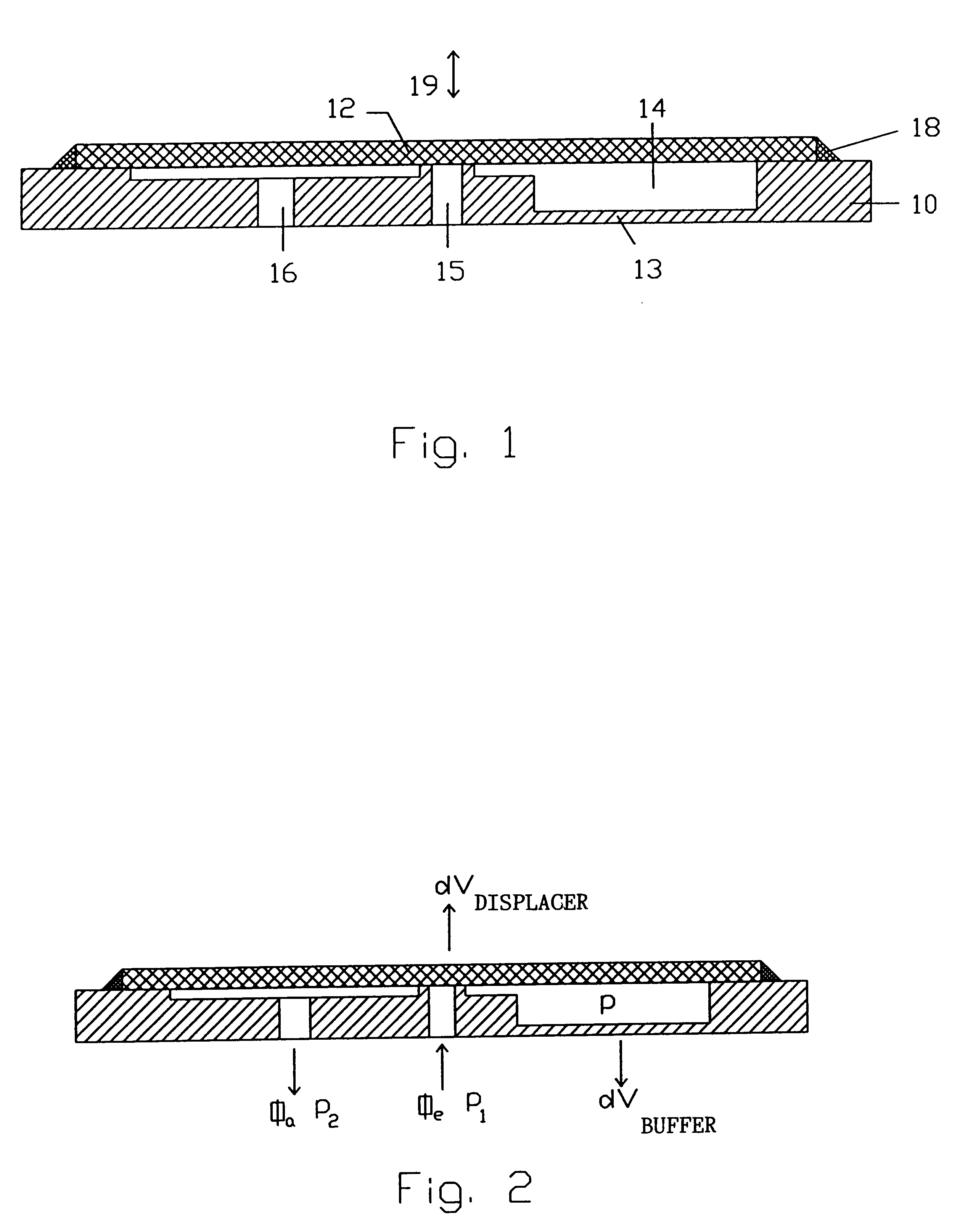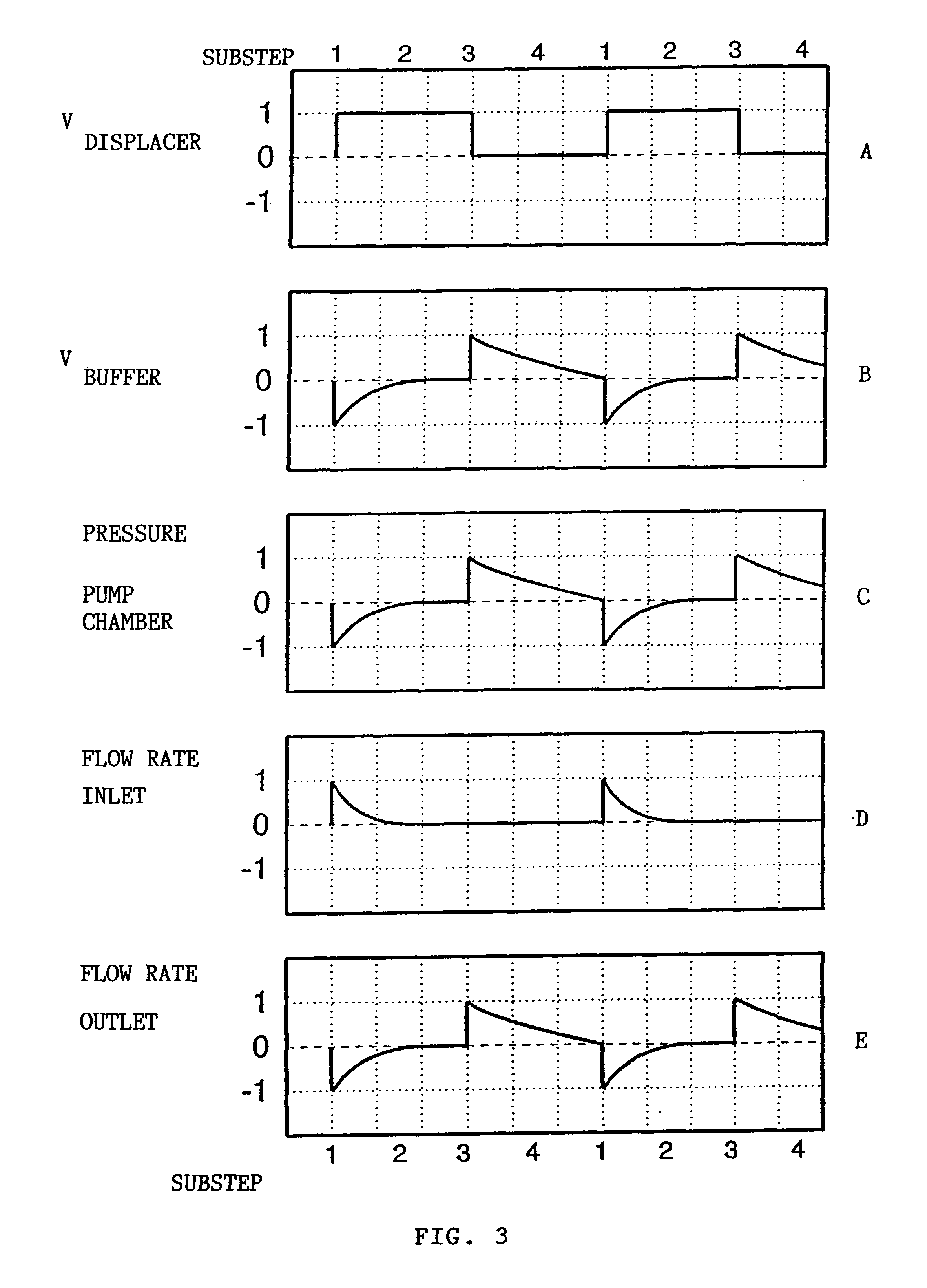Fluid pump without non-return valves
a technology of non-return valve and pump, which is applied in the direction of positive displacement liquid engine, piston pump, liquid fuel engine, etc., can solve the problems of high expenditure, low maximum pumping efficiency, and range of 10 to 20%
- Summary
- Abstract
- Description
- Claims
- Application Information
AI Technical Summary
Benefits of technology
Problems solved by technology
Method used
Image
Examples
first embodiment
Let us assume that the hydrostatic pressure p1 prevails on the inlet side, the hydrostatic pressure p2 on the outlet side and the pressure p in the pump chamber. The flow rate through the two openings is referred to as .phi..sub.e for the inlet opening 15 and .phi..sub.a for the outlet opening 16. The displacer, whose position of rest corresponds to the first end position at which the inlet opening is closed in accordance with the first embodiment, is moved to its second end position by actuating the drive means, whereby the volume of the pump chamber is changed by a defined volume amount dV*. A pressure-dependent volume displacement of the elastic buffer is referred to as V.sub.buffer. It is positively weighted when the diaphragm 13 bulges out of the pump chamber 14 and negatively weighted when said diaphragm is deformed into the interior of said pump chamber 14.
The volume of the pump chamber is consists of a basic volume V.sub.0 of the pump chamber 14, the deflection of the displa...
third embodiment
FIG. 6 shows a further fluid pump. A pump body 50 of this third embodiment has the same structural design as the pump body 40 of the pump shown in FIG. 5, with the exception that the elastic buffer is not formed in said pump body. The pump body 50 has again arranged therein a displacer 52 which is adapted to be moved like a piston in the direction of arrow 19. When seen in a cross-sectional view, the displacer 52 has the shape of an H, one leg of said H being provided with a projection 52a used for closing an inlet opening 55 in the pump body 50. An outlet opening 56 in the pump body 50 is always open. The displacer 52 is implemented such that it is adapted to close the pump body 50 towards the open side thereof. Depending on the shape of the pump body 50, said displacer can have an arbitrary round, polygonal, elliptical, etc., shape.
On the basis of the shape of the displacer 52, a pump chamber 54 is again defined between the displacer 52 and the pump body 50. In contrast to the pum...
second embodiment
FIG. 9 shows a pump according to the present invention.
In this embodiment, the displacer 82 is part of a second pump body 90. The second pump body 90 is structured, i.e. it is provided with portions of increased thickness and with portions of reduced thickness 89 so as to provide an elastic suspension for the displacer 82. The second pump body 90 is secured to a pump body 80 via connections 88. The pump chamber 84 is formed as a capillary gap between the pump body 80, the displacer 82 and the second pump body 90. The pump body 80 is provided with an inlet opening 85 which is closed by the displacer 82 when said displacer occupies the first end position. The displacer 82 can again be moved in the direction of arrow 19. The second pump body 90 is provided with two outlet openings 86a and 86b. The buffer of this embodiment is again implemented as a diaphragm located in said pump body 80.
In accordance with an alternative embodiment, the buffer could be realized by the portions of reduce...
PUM
 Login to View More
Login to View More Abstract
Description
Claims
Application Information
 Login to View More
Login to View More - R&D
- Intellectual Property
- Life Sciences
- Materials
- Tech Scout
- Unparalleled Data Quality
- Higher Quality Content
- 60% Fewer Hallucinations
Browse by: Latest US Patents, China's latest patents, Technical Efficacy Thesaurus, Application Domain, Technology Topic, Popular Technical Reports.
© 2025 PatSnap. All rights reserved.Legal|Privacy policy|Modern Slavery Act Transparency Statement|Sitemap|About US| Contact US: help@patsnap.com



